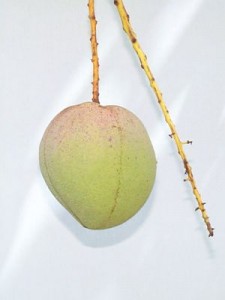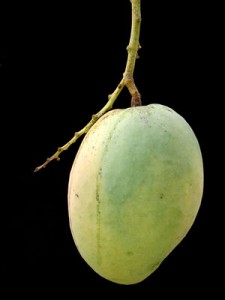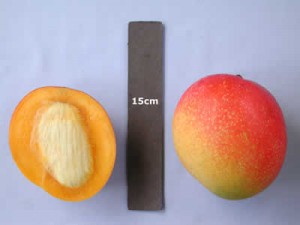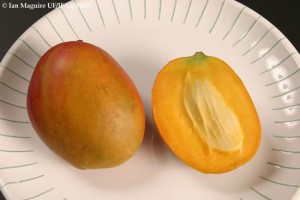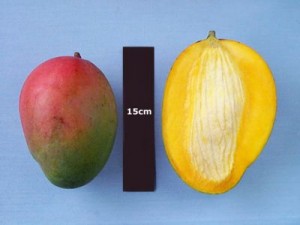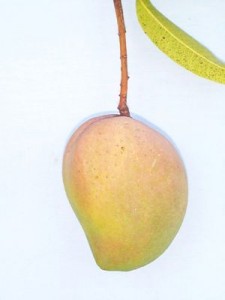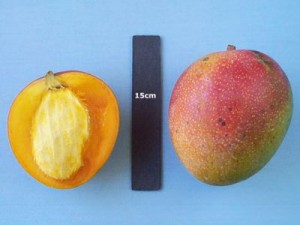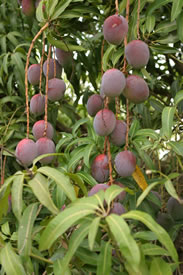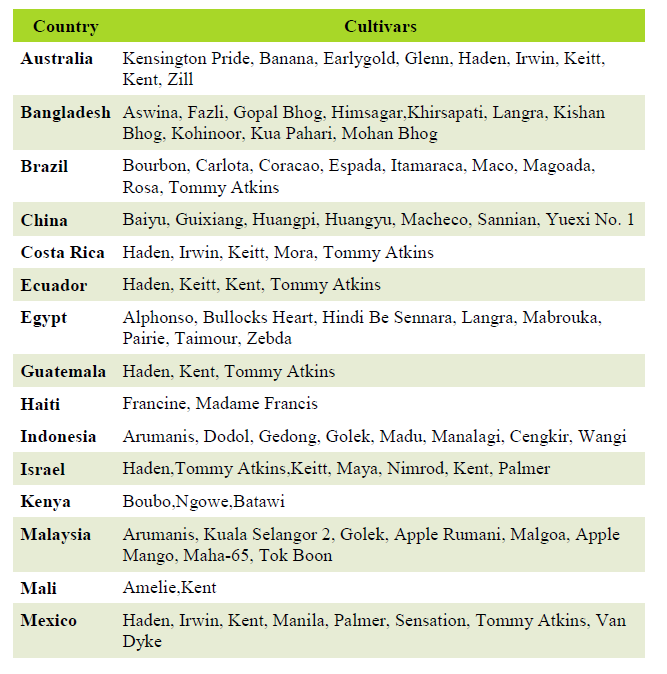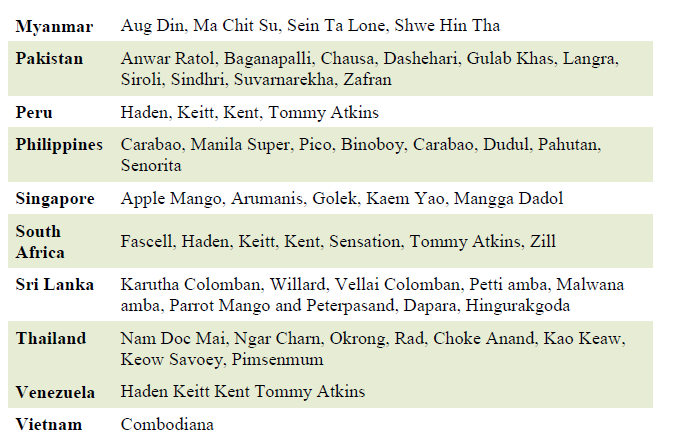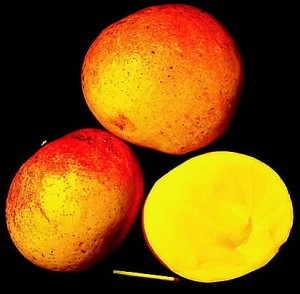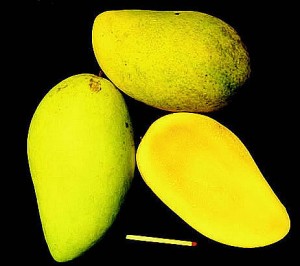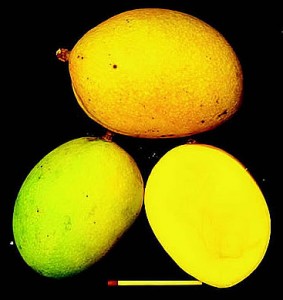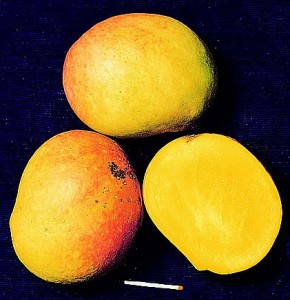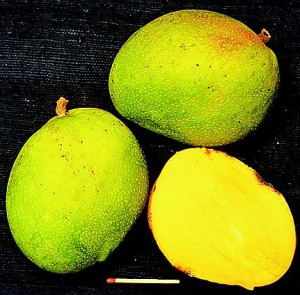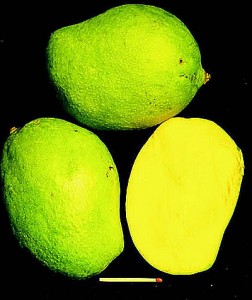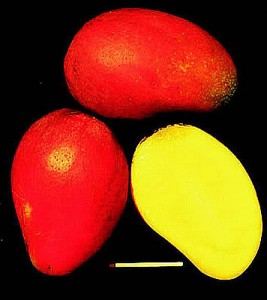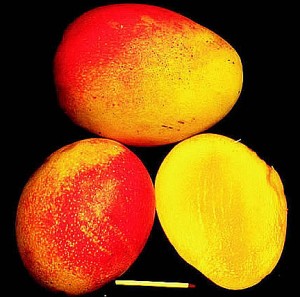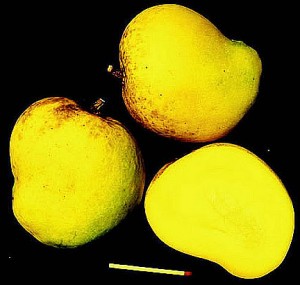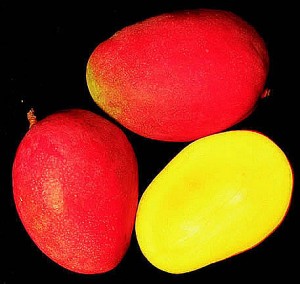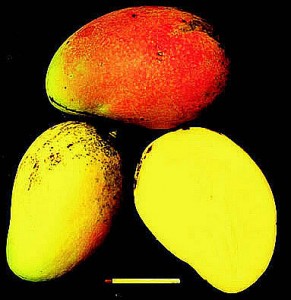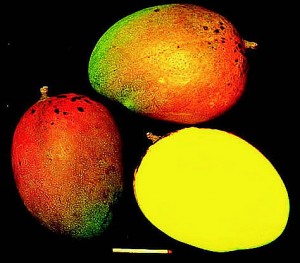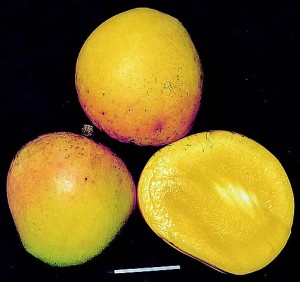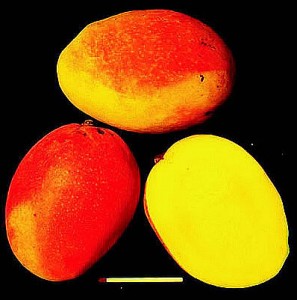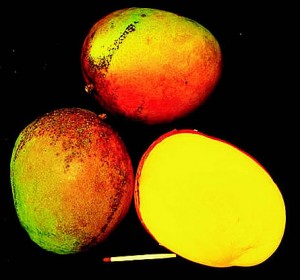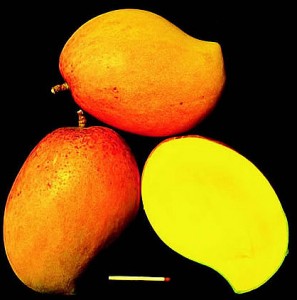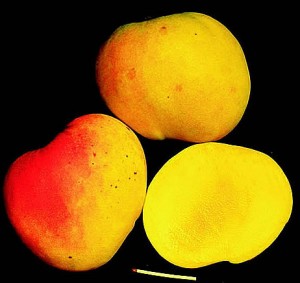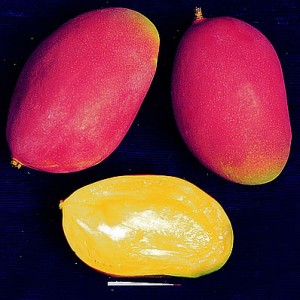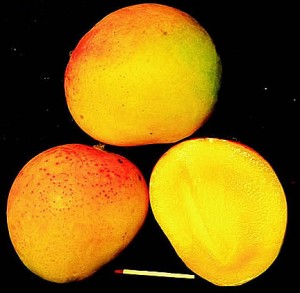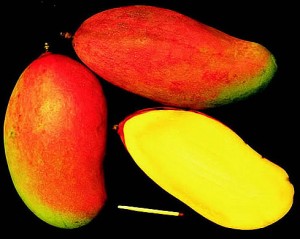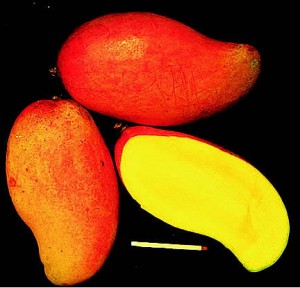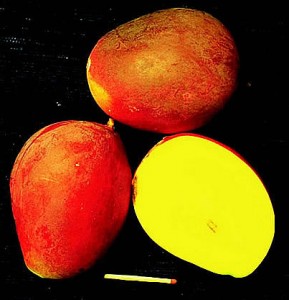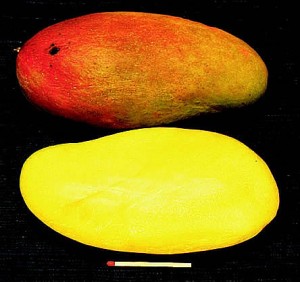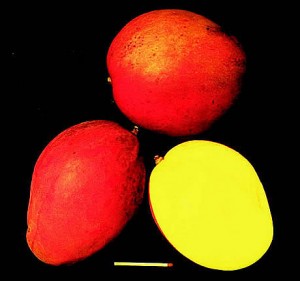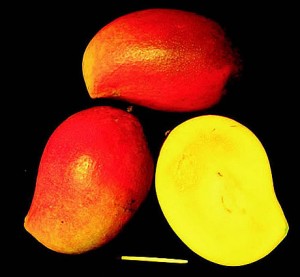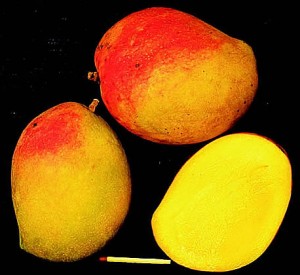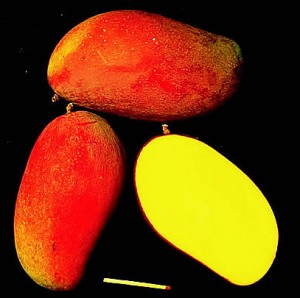Back to > Major Fruits | Minor Fruits | Underutilized Fruits
![]()
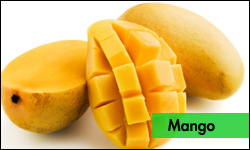 |
||
|
|
||
Distribution and cultivars:
Classification:
Origin: The mango is native to southern Asia, especiallyBurma and easternIndia. It spread early on to Malaya, eastern Asia and easternAfrica. Mangos were introduced toCalifornia (Santa Barbara) in 1880.
Forms: The mango exists in two races, one fromIndia and the other from thePhilippines andSoutheast Asia. The Indian race is intolerant of humidity, has flushes of bright red new growth that are subject to mildew, and bears monoembryonic fruit of high color and regular form. The Indo-china and Philippine race tolerates excess moisture, has pale green or red new growth and resists mildew. Its polyembryonic fruit is pale green and elongated kidney-shaped.Philippines types fromMexico have proven to be the hardiest mangos inCalifornia.
Adaptation: Mangos basically require a frost-free climate. Flowers and small fruit can be killed if temperatures drop below 7.22° C, even for a short period. Young trees may be seriously damaged if the temperature drops below -1.1° C, but mature trees may withstand very short periods of temperatures as low as -3.9° C. The mango must have warm, dry weather to set fruit.
Common names
Mango, Mangot, Manga, Mangou
Related species: Bindjai (Mangifera caesia), Horse Mango (M. foetida), Kuweni mango (M. odorata).
Distant affinity: Cashew (Anacardium occidentale), Gandaria (Bouea gandaria), Pistachio (Pistacia vera), Marula (Sclerocarya birrea), Ambarella (Spondias cytherea), Yellow Mombin (Spondias mombin), Red Mombin (Spondias purpurea), Imbu (Spondias tuberosa).
Recommended varieties/ cultivars
Clone characteristics and cultivars:
(a) Mango Cultivars: There are hundreds of mango cultivars distributed throughout the world, of which Asia andIndia have over 500 classified varieties have evolved and have been described and 69 species mostly restricted to tropical regions. Perhaps some of these varieties are duplicates with different names, but at least 350 are propagated in commercial nurseries. The highest diversity occurs inMalaysia, particularly in peninsular Malaya, Borneo andSumatra, representing the heart of the distribution range of the genus. The natural occurrence of all the Mangifera species extends as far north as 27 º latitude and asFar East as the Caroline Islands. Wild mangoes occur inIndia,Sri Lanka,Bangladesh,Myanmar,Sikkim,Thailand,Kampuchea,Vietnam,Laos, southernChina,Malaysia,Singapore,Indonesia,Brunei, thePhilippines,Papua New Guinea and the Solomon andCaroline Islands. Maximum species diversity exists in westernMalaysia and about 28 species are found in this region. However, in the Western Hemisphere, a few cultivars (125) derived from a breeding program inFlorida are the most popular for international trade.
A typical adult-bearing age mango tree must have desirable vegetative characteristics, especially:
(i) tree shape or form, good leaf orientation, leaf shape, good floral and fruit characteristics and the tree should be normal, well-balanced, in good health and exhibiting normal growth.
(ii) The tree should also have the following important characteristics:
(iii) High salt tolerance
(iv) High heat and cold tolerance
(v) High disease and insect resistance
(vi) High drought tolerance
(vii) High yields
(viii) Minimal turpentine-like off-taste fruits
(ix) low fiber content fruits
(x) Long harvest season
(b) Grown varieties and cultivars:
(i) Varieties grown in Florida and Hawaii, USA
Aloha: OriginSan Diego, Jerry Staedeli, 1971. From Hawaiian seed. Tree spreading, light bearer, according to rootstock affinity. Fruit large (14-18 oz.), dull yellow covered with red. Early (Oct-Nov). Susceptible to anthracnose. For coast.
Brooks: OriginMiami, 1916. Seedling of Sandersha. Tree somewhat dwarf. Fruit medium to large (10-20 oz.), kidney-shaped, green with yellow shoulder, rather fibrous. Very late. Resistant to anthracnose. For greenhouse and containers.
Cambodiana: OriginMiami, 1910. Seedling ofSaigon. Philippine type. Fruit small to medium, elongated ovate, yellow-green, juicy, flavor acid. Early. For greenhouse.
Carabao: OriginPhilippines. Philippine type. Fruit medium (10 oz.), elongated, kidney-shaped, light green blushed yellow. Seed very large, flesh stringy, acid, juicy. Early midseason. For greenhouse.
Carrie: Origin Delray Beach, Florida, 1940. Seedling of Sophie Fry. Tree dwarf. Fruit varies from small to 12 oz., regular ovate, green-yellow, fiberless, flavor high. Early. For foothills, interior and greenhouse.
Cooper (syn. Cooper No. 1 or 3): OriginHollywood, Floyd Cooper, 1948. Tree spreading, dense. Fruit large (16-20 oz.), long, green. Flesh high quality. Late. For foothills.
Costa Rica: OriginEast Los Angeles, Gilbert Guyenne, 1980. >From seed fromCosta Rica. Fruit small to 10 oz., elongated, flat, pale green, juicy. Very early. For coast and foothills.
Doubikin: Origin Kelmscott, West Africa,Arnold Doubikin, 1965. Two sibling seedlings of Kensington pass under this name. Tree dwarf, rounded, slow growing, fruits in two years from seed. Polyembryonic. Fruit round, large (12-16 oz.), midseason. For coast, foothills, greenhouse.
Earlygold:Origin Pine Island,Florida, 1943. Tree upright. Fruit medium to 12 oz., obliquely round, orange with red blush, fiberless, seed often abortive. Very early. Resistant to anthracnose. For coast.
Edgehill: OriginVista,Calif., Paul Thomson, 1920s. Indian type. Tree upright, hardy, vigorous. Monoembryonic. Blooms early. Produces small to medium (8-12 oz.), almost fiberless fruit, green with red blush. Resists mildew, subject to soft nose. Midseason (Nov-Dec). For foothills.
Edward: OriginMiami, Edward Simmons, 1948. Hybrid of Haden X Carabao. Intermediate between Indian and Philippine forms. Tree dense, compact. Fruit medium to large, elongated ovate, apex often oblique, yellow green with red blush. Seed very small, easily removed. Flavor excellent. Early. For interior.
Fascell: OriginMiami, 1936. Seedling of Brooks. Pat. #451. Tree open, slow. Fruit medium to large, elongated flattened, yellow with pink blush, flesh acid. Early. For coast and inland.
Gouveia: OriginHonolulu, Ruth Gouveia, 1946. Tree upright, open, Fruit medium to large,(10-20 oz.), long ovate, green becoming bright red. Sweet, juicy, no fiber. Late, uneven ripening. For coast and inland.
Haden: Origin Coconut Grove, Capt. Haden, 1910. seedling of Mulgoba. Indian type. Tree spreading. Fruit large (to 24 oz.), regular ovate, yellow almost covered with red, flavor mild, little fiber. Early. Susceptible to anthracnose and alternate bearing, traits imparted to its progeny. For interior and greenhouse.
Irwin: OriginMiami, F.D. Irwin, 1945. Seedling of Lippens.Florida’s leading local market cultivar. Tree very small. Fruit medium, 12-16 oz., elongated, ovate regular in form, orange yellow with deep blush, flesh bland, fiberless. Mid-season. For foothills, interior, greenhouse.
Julie: OriginTrinidad. Tree dwarf, slow growing. Fruit small (6-10 oz.), flat oblong, obliquely almost two-nosed, orange, rather fibrous, juicy, sweet. Late. For containers, greenhouse.
Keitt: OriginHomestead, 1945. Probably seedling of Mulgoba. Fruit large (20-26 oz.), ovate with slightly oblique apex, green, flesh rich, fiber only around seed. Resists mildew. Late. For interior.Florida fruiting July Aug., sometimes to Sept.
Kensington Pride (syns. Pride of Bowen, Bowen Special): OriginBowen,Queensland, 1960s. Generally propagated as seedling strain. Polyembryonic. Tree rounded, vigorous. Fruit medium to large, almost round with pink blush. Flavor sweet. Standard Australian mango cv. Fruit tends to drop at small size. Midseason. For foothills.
Kent: Origin Coconut Grove, 1944. Seedling of Brooks. Tree upright. Fruit large (20-26 oz.), regular ovate, greenish yellow with red shoulder, flesh rich, fiberless. Late midseason. For interior.
MacPherson: Origin Encinitas, L.L. Bucklew, 1944. Tree dense, low branching. Fruit small (6-8 oz.), yellow-green with red blush, flesh fairly good. Midseason. For coast.
Manila: OriginMexico, a seedling race common inVeracruz state. A seedling strain fromHawaii. Philippine type. Tree dwarf, dense. Fruit small to 10 oz., shaped long, flat, yellow, flavor sharp. Subject to anthracnose. Early (Oct-Dec), late picked fruit best. For coast and foothills.
Mulgoba: OriginBombay; distinct from ancient cv. Mulgoa. Fruit medium, 16 oz., greenhouse.
Ott: OriginLa Habra heights, William Ott, 1948. Seedling ofSaigon. Tree dwarf. Fruit medium, to six inches, orange-yellow with pink blush. Season very early.
Piña (syn. Pineapple): OriginMexico, a seedling strain. Philippine type. Tree upright. Fruit small to 12 oz., shape ovoid, orange yellow. Flavor suggests pineapple. Early midseason (Nov-Dec). For foothills.
Pirie (syn. Paheri): OriginIndia, ancient. Tree broad, spreading. Fruit small (8-10 oz.), almost round, apex oblique, yellow with red blush. Juicy, fiberless, rich flavor. Alternate bearing; blooms every 18 months. Early midseason. For greenhouse.
Reliable: OriginSan Diego,Calif., Jerry Staedeli, 1966. Seedling of Sensation. Tree broad, dense, slow. Fruit size varies from 10-20 oz., shape oblong, yellow blushed red. Rarely misses a crop. Subject to anthracnose, soft nose. Long ripening season (Oct-Feb). For coast and foothills.
Sensation: OriginMiami, 1941. Tree broad, rounded. Fruit small, round with oblique apex, yellow with red blush, fibers few. Late. For interior.
T1: OriginVista, Paul Thomson, 1969. Seedling of Edgehill. Tree low, spreading. Vigor dependent upon rootstock. Fruit medium to large, 6-8 inches, shape broad oval, green with red blush, fiberless. Subject to anthracnose, resists mildew, soft nose. Late midseason (Dec-Jan), very late on coast (Jan-Feb). For coast, foothills, interior, containers.
Thomson (syn. Thomson Large Seedling): OriginVista, Paul Thomson, 1966. Manila seedling, polyembryonic. Tree spreading, vigor dependent upon rootstock. Fruit small to medium, (6-12 oz.), yellow, shape flat, to eight inches. Resists mildew. High fiber under chemical fertilizer regime. Season early, long (September-November), ripens well indoors if picked prematurely. For coast.
Tommy Atkins: Originated from a seed planted in the 1920s atFort Lauderdale,Florida. Commercially grown for export inFlorida. Tree full, dense. Fruit medium to large, 16 oz. with thick skin, regular ovate, orange-yellow covered with red and heavy purple bloom. Firm, juicy, medium fiber, fair to good quality. Flavor poor when over fertilized and irrigated. Resists anthracnose. Early, ripens well if picked immature. For interior.
Villaseñor: OriginLos Angeles, 1950s, Sr. Villaseñor. Tree dwarf, spreading, responds to strong rootstock. Fruit medium, to 12 oz., shape ovate, color greenish yellow, pink blush, flavor mild. Late midseason (Dec Jan). For coast, foothills.
Winters (syn, M20222, Southland): Origin Miami, USDA, 1959. Seedling of Ono, Philippine type, polyembryonic. Tree broad, production variable. Fruit medium, to 14 oz., smaller in desert, shape half-round, yellow blushed red. Subject to anthracnose, resists soft nose. Parthenocarpic fruit will reach full size. Season midseason (Nov-Dec), ripens well if picked immature. For coast, foothills, interior.
Zill :OriginLake Worth, 1930. Seedling of Haden. Tree very spreading, open. Fruit small, 8-12 oz., almost round, apex oblique, yellow with blush, little fiber. Ripens early. For greenhouse planting.
Varieties grown in Hawaii, USA (Recommended varieties):
‘Ah Ping’, ‘Fairchild’, ‘Gouveia’, ‘Harders’, ‘Keitt’, ‘Momi K’, ‘Pope’, and ‘Rapoza’ are recommended mango varieties for Hawaii. All the listed varieties are productive and have superior quality fruit. They have less pronounced alternate-year bearing qualities than the more common ‘Haden’ and ‘Pirie’ varieties. All these varieties, including ‘Haden’ and ‘Pirie’, are monoembryonic and do not come true from seed. Flowering occurs from December to April, but offseason flowering is common, resulting in variable harvest times. ‘Fairchild’ is considered somewhat resistant to anthracnose and is favored for humid areas. ‘Exel’ is a high quality mango cultivar developed by the Department of Horticulture,UniversityofHawaii. It was selected from an open-pollinated population of ‘Irwin’ seedlings. Young ‘Exel’ trees begin to bear three to four years after transplanting into the orchard. ‘Exel’ bears fruit regularly, sets well and frequently flowers during the off season. Fruits usually mature in July and August but in some years, may mature as late as October. ‘Exel’ trees should be planted in sunny, dry areas to prevent anthracnose damage to immature fruit and flowers. ‘Exel’ fruits are ovate, 4 to 5.6 inches in length by 2.8 to 3.6 inches in width, with a short, rounded beak. The average fruit weight ranges from 14.1 to 17.6 ounces. The penduncle is set at the top of the fruit. Immature fruits are green with a purple blush. Mature fruits are yellow with a red over color on about half of the surface of the fruit. The flesh is firm, orange-yellow, juicy, sweet, and fiberless. The fruit has 18% total soluble solids. More than 90% of the fruit is edible flesh, because the fruit has a thin, flat seed.
(ii) Important mango cultivars in major producing countries are listed in the table below:
Advantages:
- early cultivar of excellent fruit quality
- small/medium seed size
- free from fibres
Disadvantages:
- susceptible not resistant to anthracnose and powdery mildew
- alternate bearing
- range of altitude adaptation is limited
| Apple: The fruits are medium to large, nearly round in shape and have a rich yellow/orange to red color when ripe. Average length measures 9.7 cm by 11 cm in width, and the weight is 280–580 g (mean: 397 g). Normally, if not diseased, the skin is smooth and thin, and the juicy yellow flesh is of excellent flavor and of melting texture virtually free from fiber. This is not a polyembryonic mode for reproduction: contains more than one embryo; produces true-to-type progeny cultivar and trees propagated by seed are very heterogeneous in fruit shape, color and quality.
The trees are large/ vigorous and of pyriform growth habit. Depending on location, harvesting seasons vary depending on region and the yields are medium.
|
| Arumanis: This cultivar variety, type is also referred to as Harumanis (Malaysia) and it originates from Indonesia. It is widely planted in humid parts of the world where many cultivars of better quality fail to fruit.The small, oval to oblong longer than broad fruits are yellow with large yellow-white dots and a rounded base. The beak a pointed projection at the tip of a fruit is inconspicuous and the skin is thin and tough. The flesh is firm and juicy with little fiber. It is lemon yellow, sweet, slightly insipid with a strong aroma, but with only poor to fair eating quality. The polyembryonic mode for reproduction: contains more than one embryo; produces true-to-type progeny seed is covered in a thick woody shell.
The tree is vigorous and tall with a slightly open canopy. crown of a plantIt bears towards low yields and biennial bearing. Resistance to powdery mildew and anthracnose is only low to fair.
|
| Parwin: This seedling originated from Bradenton in Florida and was released in 1954. Of unknown parentage, it resembles Haden but lacks the latter’s bright red colour. The fruit is medium to large with an average length of 10.8 cm and a width of 8.5 cm. The fruit weight ranges from 380 to 560. The shape is oblong longer than broad to ovate and tends to be plump; the basic colour is light yellow with a pink/red blush; lenticels are distinct and numerous. The fruits are often borne in clusters. The yellow juicy flesh is relatively free from fibres, moderately sweet with a good flavour. The medium-sized stone (7.5% of fruit weight) encloses the mono-embryonic mode of reproduction: contains only one embryo seed. The tree is vigorous with a slightly open habit and there is a remarkable resistance to anthracnose and powdery mildew. Yields are satisfactory and quite regular |
Reference:
- Diczbalis, Y., Wicks, C. and Landrigan, M. (1997). Heat sums to predict fruit maturity in mango (cv. Kensington Pride). Draft report for HRDC FR605 NTDPI&F.
- Johnson, P.R. and Robinson, D.R. (1997). An evaluation of mango (Mangifera indica L.) cultivars and their commercial suitability for theKimberley. Department of Agriculture. 21/97 ISSN 1326-4168 Agdex 234/34.
- Morton, J. 1987. Mango. p. 221–239. In: Fruits of warm climates. Julia F. Morton,Miami,FL.
- P.R. Johnson and D. Parr. Mango growing in Western Australia. Bulletin 4348
- Maxwell, Lewis S. and Betty M. Maxwell. Florida Fruit. Lewis S. Maxwell, Publisher. 1984. pp. 61-63
- Samson, J. A. Tropical Fruits. 2nd ed. Longman Scientific and Technical. 1986. pp. 216-234.
- Sherrard, J., Johnson, P.R. and Luke, G. (1997). Mango irrigation requirements for the Broome and Ord irrigation areas of Western Australia. Department of Agriculture. Draft report.
- Sites on Mango
- Subtropical/Trop. Fruit Crops Database: http://www.agnic.nal.usda.gov/agdb/stropfc.html
- Mango Produce Facts Linked from the Postharvest Outreach Program, UC Davis
- Mango Overview, Propagation, And Agroforestry Uses Linked from Cornell University
- All About Mangoes
- Mango Fruit Facts and Mango Publications Courtesy of California Rare Fruit Growers.
- Mango Information Linked from NewCrops, Purdue University.
- Mango Tip Burn And Sunburn Images Linked from Texas A & M.
- Mango Production Regions Linked from the Dept. of Agronomy, U.C. Davis
- Mango-Research and Development A site on various aspects related to manoes
- Mango recipes, history, varieties etc — http://freshmangoes.com. or http://freshmangoes.com/mangonews/
- Mango Index Linked Information Mango Produce Facts
- Mango Food Resource (http://osu.orst.edu/food-resource/index.html) Oregon State University, Corvallis
- Postharvest Handling of Pickling Mango
- Mango an introductory description http://www.safari.net/~lychee/mango.htm
- Mangoes – Preparation and nutrition information – Preparation, cooking, and nutritional information for Mangoes
- Mango Botanical Description
- Subtropical/Tropical Fruits Menu University of Florida.
- Subtropical/Tropical Fruit Crops National Agriculture Library, USA
- Market Asia – Technical Information (Postharvest and Market Guides) http://www.marketasia.org/tech
- Mango Mania! is page devoted to the king of fruits http://www.delphis.dm/mango.htm
- http://www.destinationtropicals.com/tropical_plants/plant_43.asp
- http://mangoseedling.com/culturalmgmt.html

